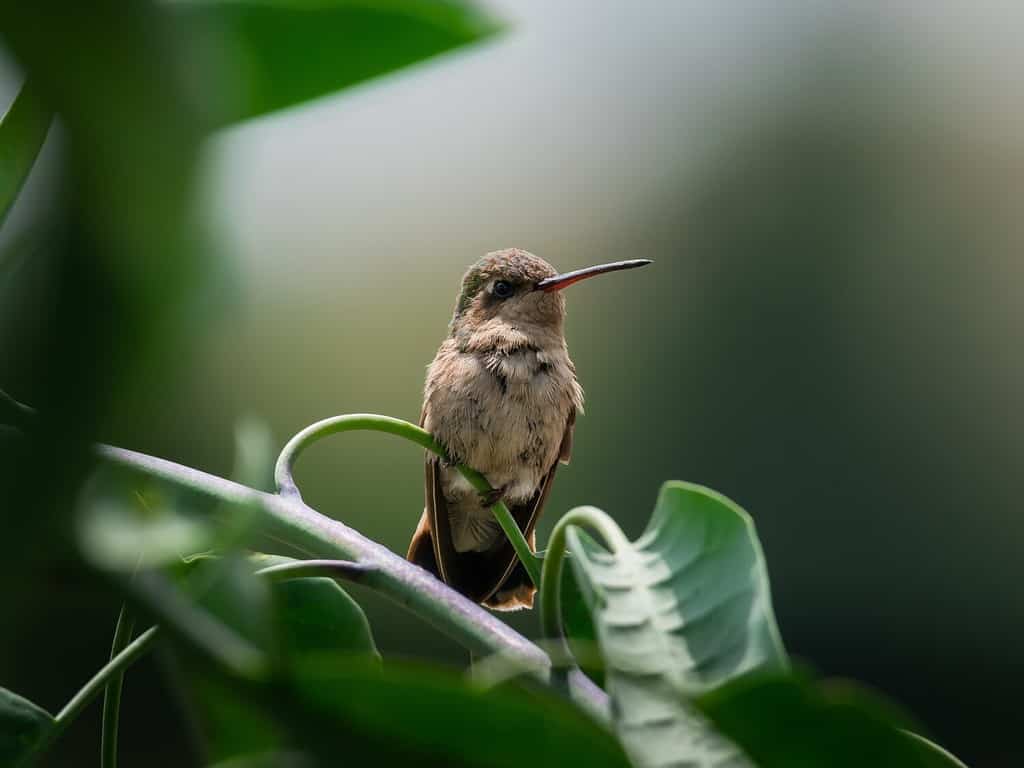
A hummingbird will starve to death if it doesn’t eat many times a day. Feeding is a great service to them!
©tferka/Shutterstock.com
Do you want to turn your yard into a hummingbird haven? If you are seeking information on how to attract hummingbirds to your yard, look no further!
Hummingbirds need to eat every 10-15 minutes because they burn energy so quickly. If they don’t, they will die. By offering food to these quick little birds, you are helping them stay alive! There are about 350 different species of hummingbirds. They are known for their tiny stature with the smallest species weighing only two grams! They can also fly backward.
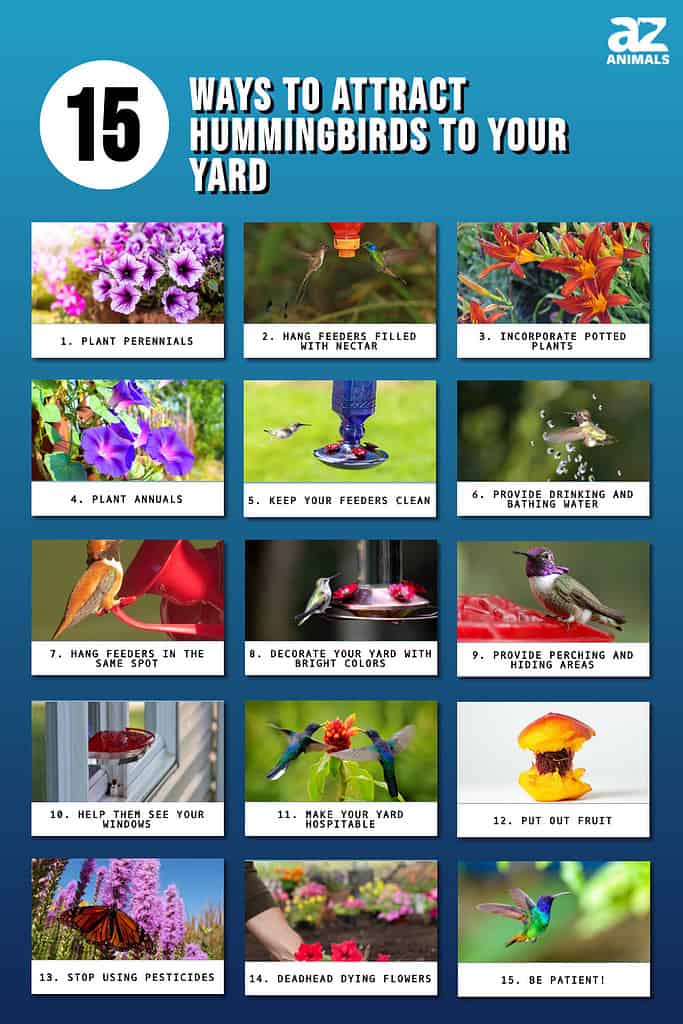
With these 15 tips, you can attract hummingbirds to your home with ease.
1. Plant Perennials
Seeing these tiny birds flutter around your flowers is always a treat! There are multiple plants you can grow in your yard to attract our flitting friends. Here are some plants that hummingbirds are drawn to:
- Petunia
- Bee Balm
- Bluestem Penstemon
- Red Columbine
- Bigleaf Lupine
- Orange Honeysuckle
- Trumpet Creeper
- Butterfly Bush
- Coral Honeysuckle
- Salvia
- Cardinal Flower
- Bleeding Heart
- Lupine
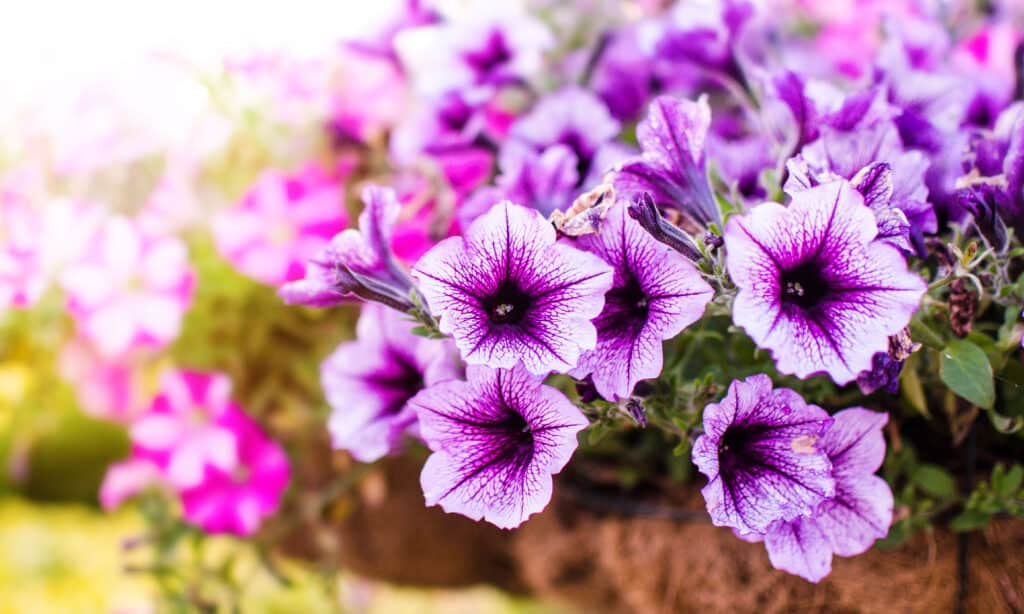
Petunias are rich in nectar and come in vibrant colors to attract the fabulous birds.
©Maya Afzaal/Shutterstock.com
A majority of these plants are long, narrow, and tubular flowers, and they all are perennials. Perennials are plants that live for more than two years. They usually grow and bloom over the spring and summer then die every autumn and winter. The plants then return in the spring from their rootstock.
These types of flowers attract hummingbirds because they are brightly colored and tubular. They tend to produce the most nectar, which is located lower down in the flower. So, the birds’ long proboscises are perfect for reaching it. As a bonus, these flowers all have intoxicating fragrances. They are all wonderful additions to creating a beautiful yard that attracts hummingbirds.
2. Hang Feeders Filled with Nectar
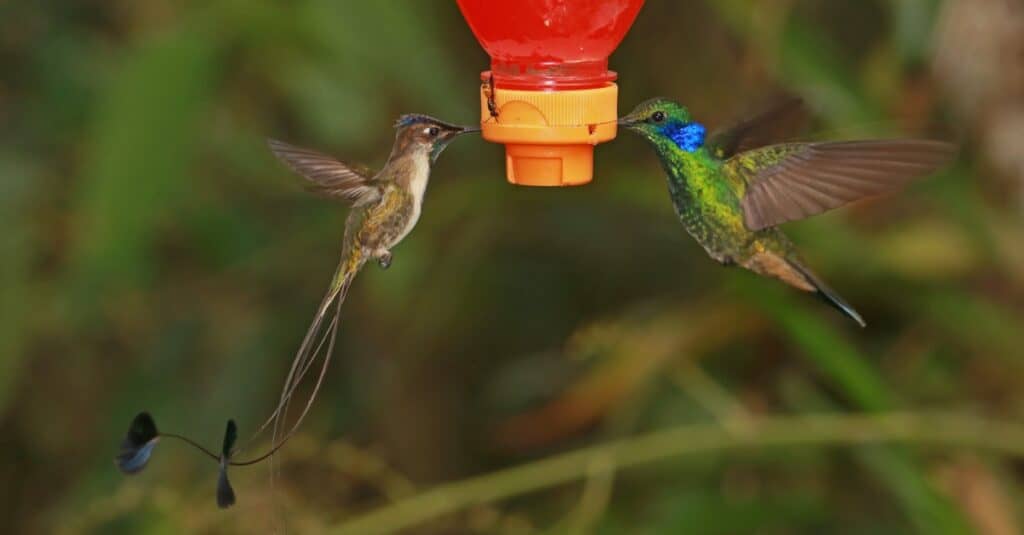
Feeders filled with hummingbird nectar will attract them to your yard.
©iStock.com/neil bowman
Hang feeders to give hummingbirds another reason to stay! Feeders come in a range of designs and price points, but all feature a reservoir for nectar, as well as a port for the tiny birds’ beaks.
Hang the feeders in a quiet spot close to plants and flowers that attract the beautiful birds. However, don’t choose a spot that is too leafy because it could obscure your viewing. You also want to make sure the spot is easily accessible so you can clean and refill the feeder with ease.
Tip: You should also hang multiple feeders and give the birds space to feed. Hummingbirds are territorial. They don’t like to share feeders, so the more you provide, the better. Also, invest in ant moats, which you can hang alongside your feeders. The moat is filled with water, deterring ants and other bugs who are attracted to sugar.
3. Incorporate Potted Plants
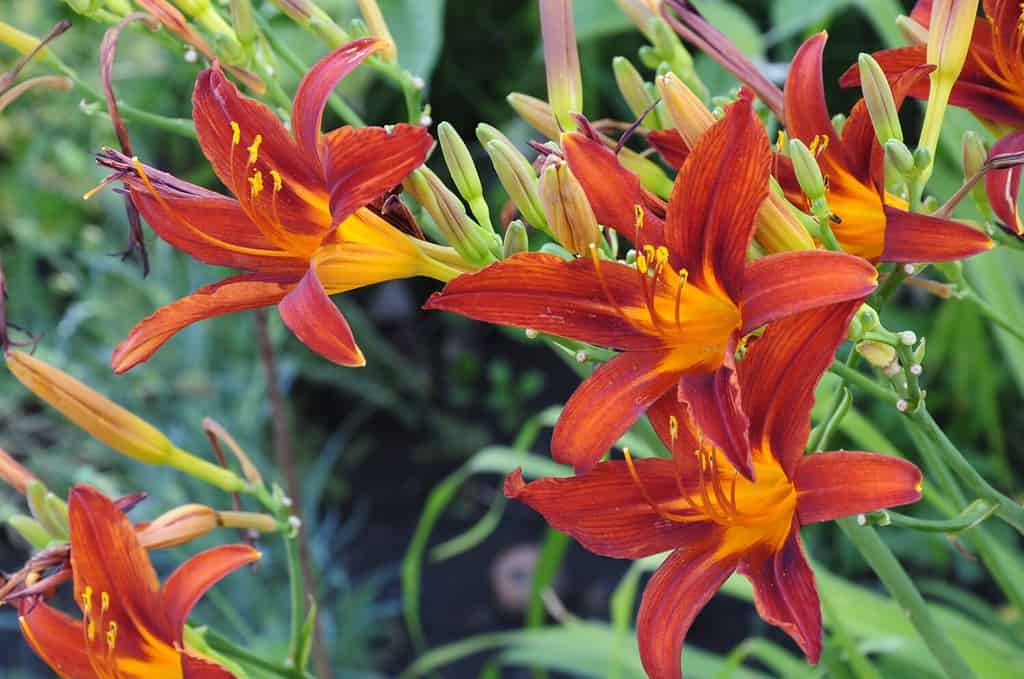
Trumpet-shaped flowers attract hummingbirds.
©Fayka2008/Shutterstock.com
If you live in an area where planting a garden is not in the cards, don’t worry! There is a plethora of potted plants that attract hummingbirds straight to your doorstep or patio. Hummingbirds have amazing memories. In fact, they remember every flower and feeder they’ve visited and how long it takes for flowers to refill with nectar!
A potted plant hummingbird garden can consist of multiple pots. If you have a smaller space, you can even mix some species together in one pot. It doesn’t have to be expensive or complex. You can even plant the flowers in recycled containers, like liter soda bottles.
These flowers include:
- Cigar Plant
- Impatiens
- Begonia
- Lantana
- Bee Balm
- Daylily
- Fuchsia
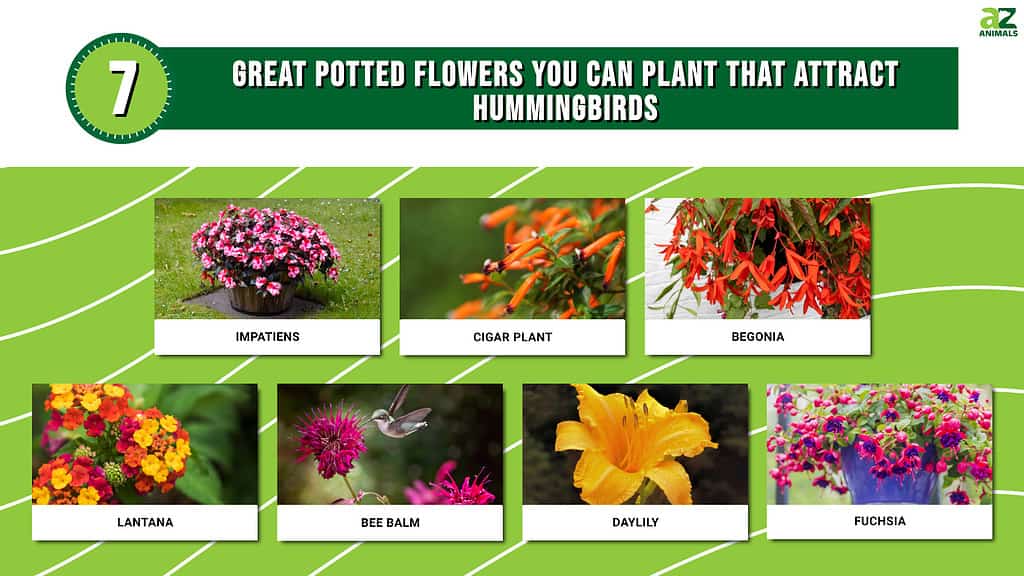
Again, the majority of these plants are trumpet-shaped and bloom in bright colors. They are also easy to grow. For example, the daylily is a low-maintenance flower that makes a great potted plant. All of these plants will attract hummingbirds to your garden!
4. Plant Annuals
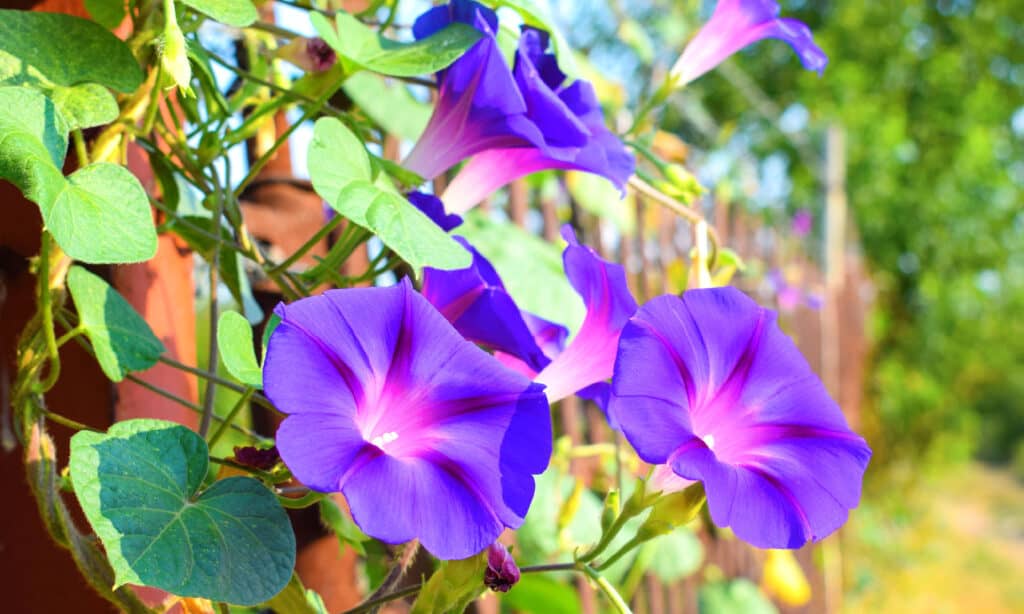
Hummingbirds find morning glories quite appetizing.
©iStock.com/Wakhron
Annuals, unlike perennials, die in the winter season, so you must replant them every year. Though birds don’t care about flowers’ growing cycle, they do have a preference when it comes to color and shape. They can be picky birds, but certain annuals attract them every time.
Some of these annuals include:
- Impatiens
- Morning Glory
- Petunias
- Cleomes
- Flowering Tobacco
- Salvia
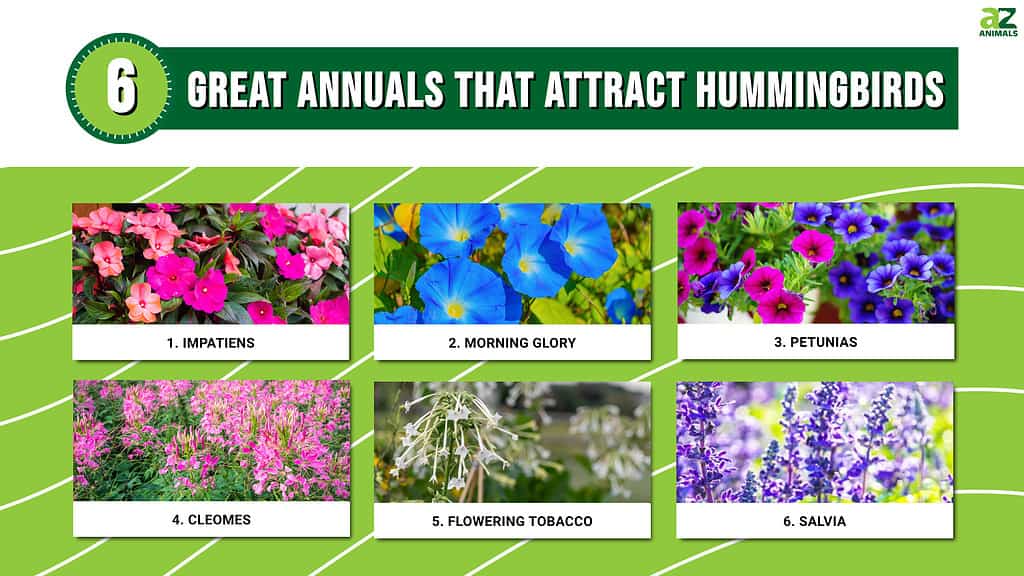
You may notice that salvia is also on the perennial list. This flower is a lovely aromatic that can be planted as an annual or a perennial. A couple of the flowers also attract butterflies and bees. These plants require more care and attention, as they have to be cut off at ground level or pulled out of the ground when they die.
5. Keep Your Feeders Clean

When not in use, the tongue of a hummingbird coils up inside its head and around its eyes!
©Eleanor McDonie/Shutterstock.com
Just as you don’t like old and moldy food, neither do hummingbirds! They want to eat sweet, fresh nectar from a clean plate. The sugar water ferments when it goes bad. You must replace it before this happens. The shelf life depends on a couple of factors, but the most important one is the weather.
If you live in a hot and humid climate, you need to change the liquid every few days. However, if the feeder can sit in the cool shade, the sugar water can last up to a week or longer.
As you change the sugar water, you should also scrub your feeders to rid them of any mold or impurities. If the bacteria aren’t eliminated, the fresh sugar water spoils quicker. And hummingbirds are not attracted to rotten nectar.
6. Provide Drinking and Bathing Water
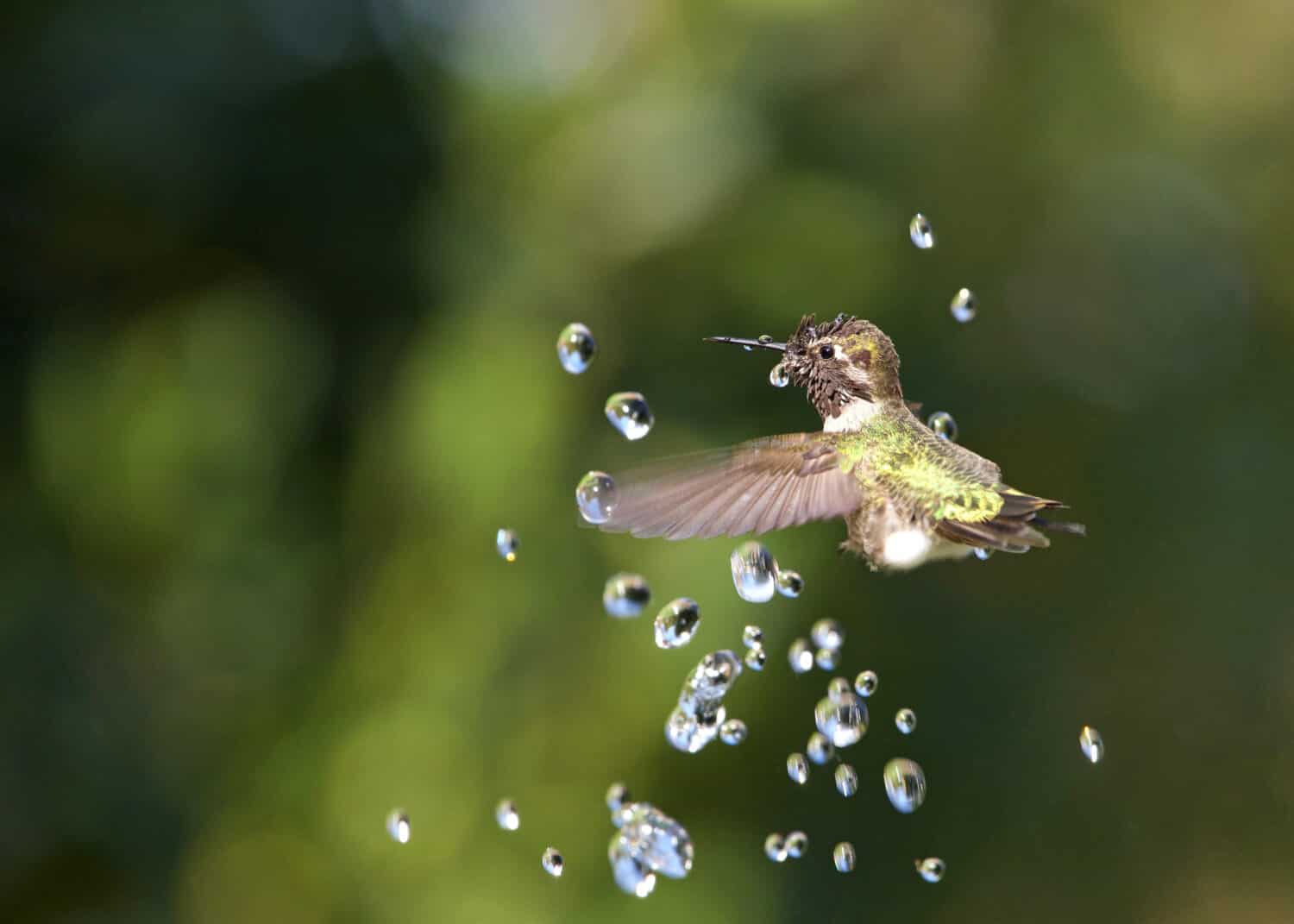
There are more hummingbirds in Central and South America than in North America
©Sheila Fitzgerald/Shutterstock.com
Hummingbirds also need fresh water to drink alongside their sweet nectar. They also enjoy bathing; however, bird baths are not particularly inviting. The water is stagnant and deep. Instead, opt for a gently moving water feature or a mister that acts as a spa area. They even zip through sprinklers for a quick cool down.
7. Hang Feeders in the Same Spot
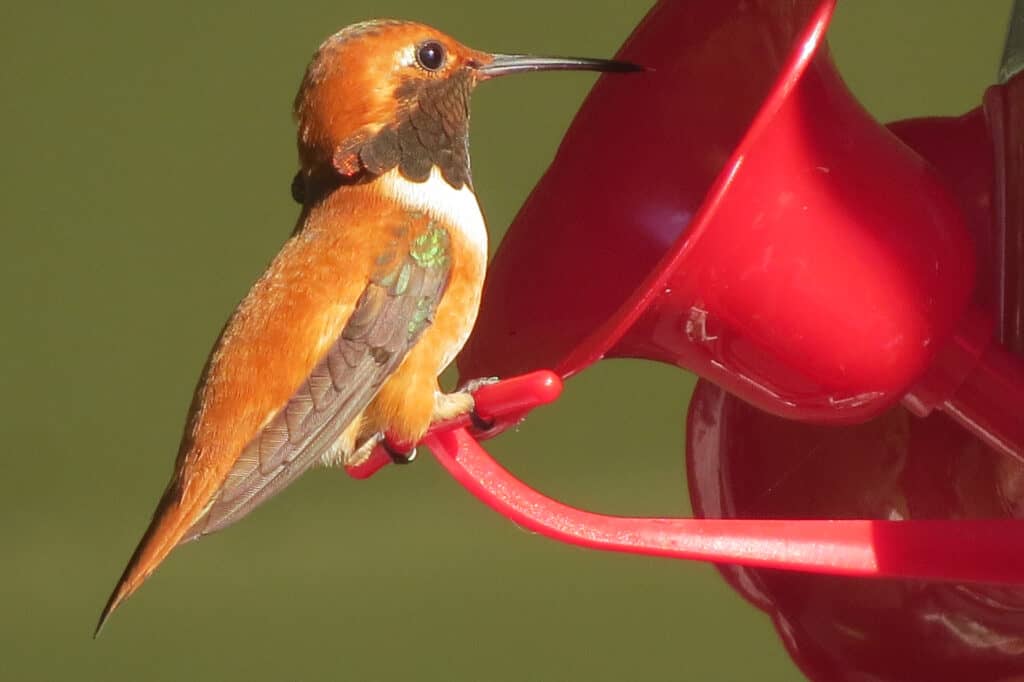
When feeding at a hummingbird feeder, Rufous hummingbirds like to perch if they can.
©Rachel Lambert/Shutterstock.com
Just as hummingbirds remember flowers, these tiny creatures are also good at remembering the location of feeders. Their spatial memory is incredible. Once you attract them, they will always come back for more. So, make sure you continue to hang your feeders in the same spot.
Additionally, don’t let your feeders go dry. If they believe their food source is no longer reliable, they will find others.
8. Decorate Your Yard with Bright Colors
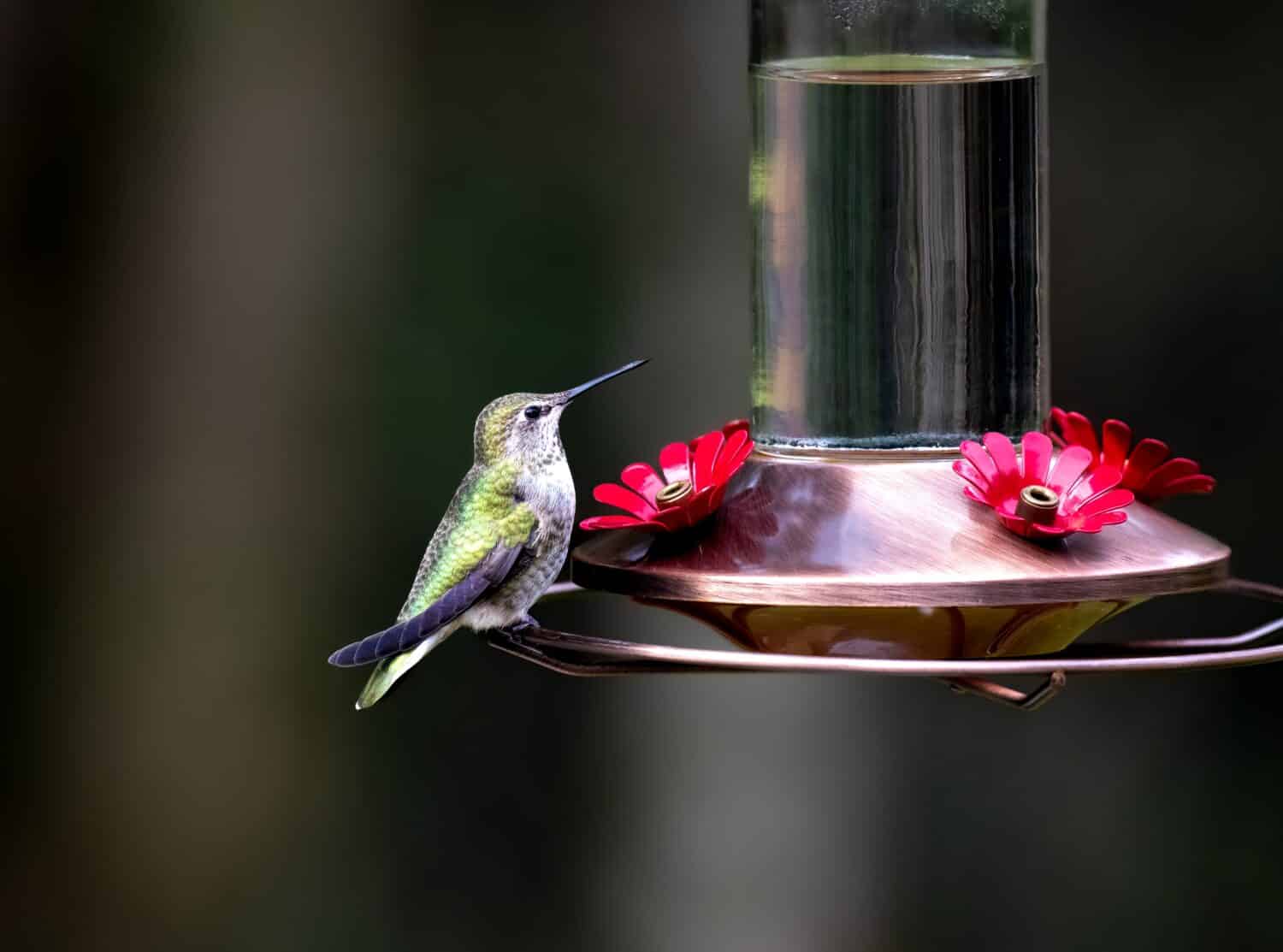
Hummingbirds are the fastest animals in the world regarding speed based on body lengths per second.
©Jeff Westhead/Shutterstock.com
Though bright flowers with sweet nectar attract hummingbirds, bright objects in general also do the trick. Orange and red are the colors most attractive to hummingbirds. Garden decorations in these colors throughout your outdoor space will attract passing hummingbirds.
You can also tie red or orange plastic ribbons to trees and shrubs on your property. Hummingbirds will fly by to check out the flapping flashes of color and notice your welcoming garden.
9. Provide Perching and Hiding Areas

These tiny creatures can perch on certain feeders, helping them stay in your yard for long periods of time.
©Rick Scuteri/Shutterstock.com
Even though hummingbirds eat every 10-15 minutes, they still spend a lot of time resting. This means that they look for nectar near places to perch. If your yard is lacking natural resting places, you should plant trees, shrubs, or bushes for hummingbirds to perch, hide, or even take shelter. A barren yard would be hard-pressed to attract hummingbirds. They won’t feel comfortable or safe. The more shelter and shrubbery around, the safer they feel. They may even nest! You can even buy hummingbird swings to place on your patio, deck, or near a feeder.
You definitely need a place for hummingbirds to perch if you are offering them water. Once the tiny creatures are wet, they usually need to preen.
10. Help Them See Your Windows

This hummingbird feeder may help alert the bird that a window is in its path.
©Jaclyn Vernace/Shutterstock.com
Birds of all kinds run into windows because they are confused by the reflection. They see trees or an open sky and believe it is a place to fly. Hummingbirds are tiny and fly at high speeds, so running into hard glass is dangerous. In order to protect hummingbirds from these collisions, feeders should be placed 15 to 20 feet away from any window.
Also, you can place leaf-shaped clings to your windows. Window feeders can bring hummingbirds right to you and reduce collisions because the feeder breaks up the reflection. However, if you see an uptick in collisions due to the feeder, take it down and try a different tactic.
11. Make Your Yard Hospitable
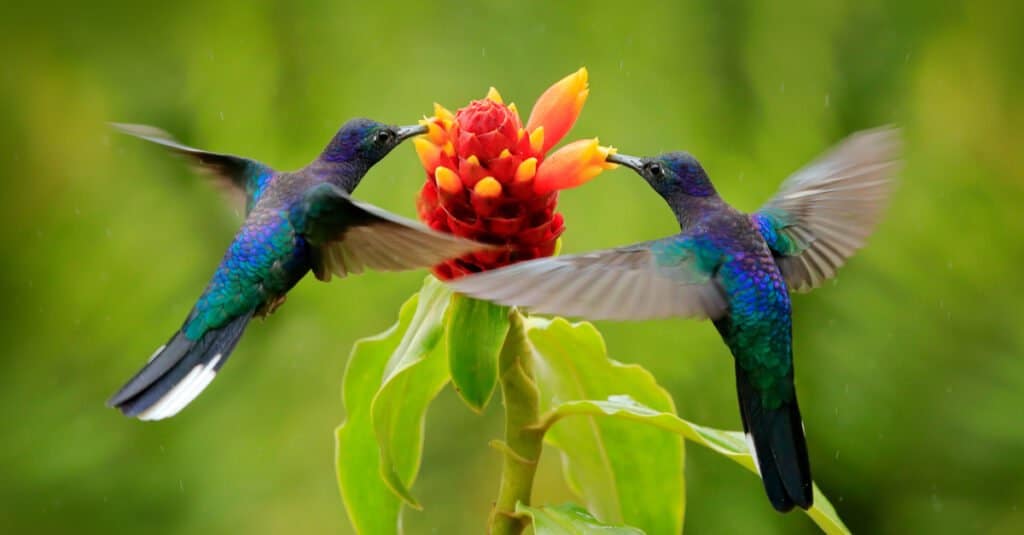
Birds, such as these hummingbirds, possess a cloaca, which expels both urine and feces.
©Ondrej Prosicky/Shutterstock.com
Just as hummingbirds need branches to perch, they also need them to help build their nests. The tiny creatures won’t occupy a birdhouse or nesting box. They build their nests in trees and shrubs with leaves, twigs, plant fibers, and other natural materials. The birds bind everything together with spider silk!
If you have spiders in your yard, hummingbirds will find your property appealing. Hummingbirds also eat spiders, along with other small insects and larvae.
It is best to only grow native plants, as they attract significantly more bugs than exotic plants. These insects contribute to their diets.
12. Put Out Fruit

Instead of throwing out old fruit rinds, leave them for hummingbirds.
©Nerza/Shutterstock.com
Along with spiders, fruit flies are also an excellent source of protein for hummingbirds. If you have fruit that has gone bad, it is perfect hummingbird bait. Find a place in your garden, preferably someplace hidden, and set the fruit out for the birds. The rotting fruit will bring plenty of fruit flies to attract the buzzing beauties.
13. Stop Using Pesticides

Pesticides don’t help any part of keeping a garden for the purpose of attracting wildlife.
©Media Marketing/Shutterstock.com
Pesticides eliminate bugs, which provide a significant source of potential food. They can also harm hummingbirds directly. For a more wildlife-friendly garden, opt for natural ways to deal with bugs and weeds.
14. Deadhead Dying Flowers
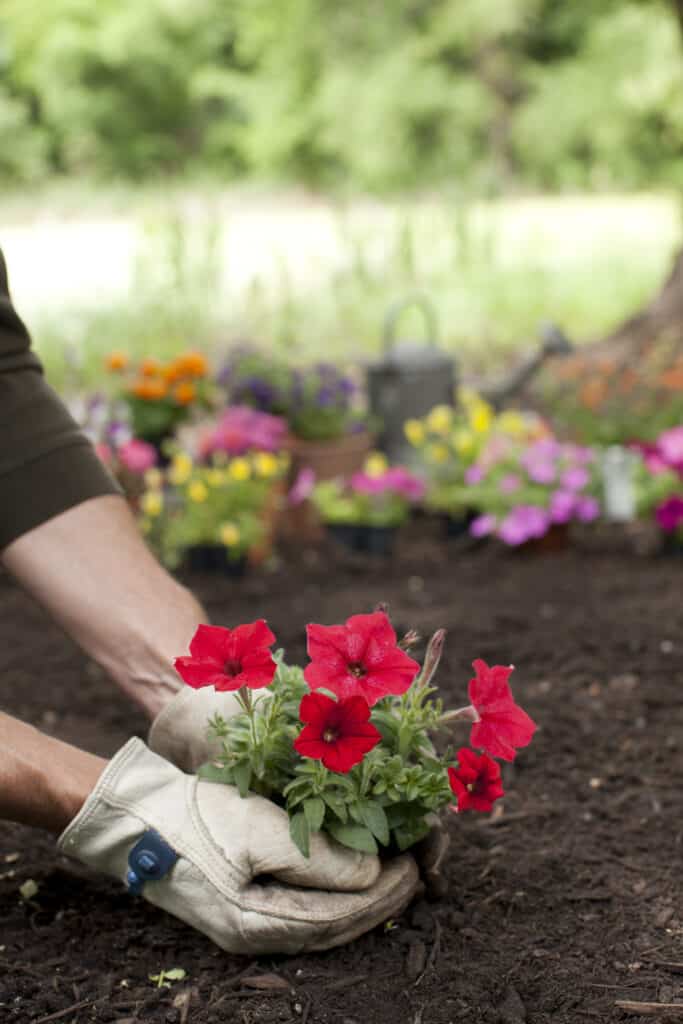
Deadheading keeps plants bright and vibrant, which attracts hummingbirds.
©iStock.com/Liliboas
Hummingbirds are attracted to bright, live flowers. Deadheading refers to the removal of flowers from a plant. This encourages new and longer blooms, which help your colorful visitors thrive.
Deadheading also enhances the overall appearance of flower beds. It not only keeps flowers looking better longer, but it also directs energy into stronger growth. This means more flowers instead of unwanted seed pods.
15. Be Patient!
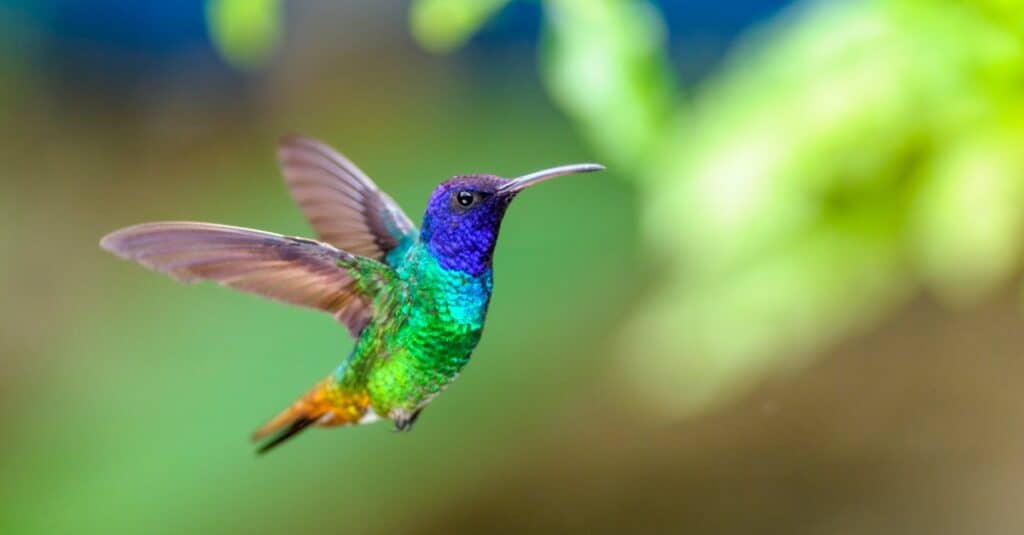
Hummingbirds beat their wings up to 90 times per second!
©iStock.com/photofxs68
Once you create a backyard oasis for hummingbirds, the next step is to simply wait. Just because the right flowers are planted, the yard is decorated, and feeders are out, doesn’t mean hordes of hummingbirds will flock to your home.
Make sure your expectations aren’t too high. It can take days, weeks, months, or even years before hummingbirds find your haven. But once they know that the food sources you provide are reliable, they will add your yard to their route. So, don’t get discouraged! Maintain a hummingbird-friendly garden and wait for the magic to happen.
Summary of 15 Ways to Attract Hummingbirds to Your Yard
| Ways to Attract Hummingbirds | |
|---|---|
| 1 | Plant Perennials |
| 2 | Hang Feeders Filled with Nectar |
| 3 | Incorporate Potted Plants |
| 4 | Plant Annuals |
| 5 | Keep Your Feeders Clean |
| 6 | Provide Drinking and Bathing Water |
| 7 | Hang Feeders in the Same Spot |
| 8 | Decorate Your Yard with Bright Colors |
| 9 | Provide Perching and Hiding Areas |
| 10 | Help Them See Your Windows |
| 11 | Make Your Yard Hospitable |
| 12 | Put Out Fruit |
| 13 | Stop Using Pesticides |
| 14 | Deadhead Dying Flowers |
| 15 | Be Patient! |
Thank you for reading! Have some feedback for us? Contact the AZ Animals editorial team.








